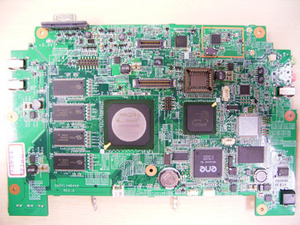
So at the very least the OLPC project has delivered the Tonka Truck of the computer world, bright, bold and hard to break. This is good work in itself, but it is just a small part of why the OLPC is such a revolutionary design.
 The CPU is an AMD Geode GX2-500. This includes MMX and 3DNow! extensions as you might find on an ordinary AMD chip, and a 32KB cache. Clocked at 366MHz this is not the sort of CPU you’d want to use to crunch astrophysics numbers, but with the power consumption at a measly one Watt it’s very easy to see the appeal.
The CPU is an AMD Geode GX2-500. This includes MMX and 3DNow! extensions as you might find on an ordinary AMD chip, and a 32KB cache. Clocked at 366MHz this is not the sort of CPU you’d want to use to crunch astrophysics numbers, but with the power consumption at a measly one Watt it’s very easy to see the appeal.
The motherboard uses an AMD CS5536 South Bridge and mounts 128MB of memory. Data storage is something of a bugbear for the OLPC design, and with hard drives being notorious for breaking due to moving parts a flash drive is used instead, providing the system with half a GB of storage. This is not much for the sort of laptop or PC that most of us would be used to, but for what the OLPC PC requires it is acceptable. There are no optical drives, though the computer has three USB 2.0 connectors to give it a good deal of versatility for other devices to be fitted.

 In general laptop construction it is usually presumed that about half of the price of the unit itself goes on the display. In the case of the $100 PC, this doesn’t give you a whole lot of money to play with. However, par for the course with the OLPC design, the display is something we’ve not seen before. The 7.5in TFT 1200x900 resolution screen has two modes in which it can run - either high definition reflective monochrome mode (using light from outside to read the screen) or a colour mode akin to that used by traditional laptops. The computer also features an internal microphone and stereo speakers.
In general laptop construction it is usually presumed that about half of the price of the unit itself goes on the display. In the case of the $100 PC, this doesn’t give you a whole lot of money to play with. However, par for the course with the OLPC design, the display is something we’ve not seen before. The 7.5in TFT 1200x900 resolution screen has two modes in which it can run - either high definition reflective monochrome mode (using light from outside to read the screen) or a colour mode akin to that used by traditional laptops. The computer also features an internal microphone and stereo speakers.
Networking the OLPC is carried out by a wireless system. Each computer can act as an ad hoc network to others nearby. The case features large coaxial rotating antennae, which when deployed give the computer what look to be rabbit ears but provide extended reception range. One of the advantages that the OLPC team have in the networking design is that their system will be pretty much the only one around and networking identical systems is always much easier than trying to accommodate a range of different computers with different operating systems and specifications.
With a reliable power supply so rare in the developing world, the power usage of the OLPC system is one of the paramount concerns and they have taken a two pronged attack on the problem. Firstly by making their computer run on very little power, secondly by implementing new and more reliable ways to recharge the battery in the middle of nowhere.
The efficiency comes from the components themselves. The AMD Geode CPU consumes a single Watt of power in use and can suspend running when the computer is being used as a book. The display when in monochrome mode isn’t backlit, and this reliability on external light means again that much less power can be used. These energy saving measures mean that the OLPC design is able to run at only 10% of the power usage of a normal laptop PC.

The motherboard uses an AMD CS5536 South Bridge and mounts 128MB of memory. Data storage is something of a bugbear for the OLPC design, and with hard drives being notorious for breaking due to moving parts a flash drive is used instead, providing the system with half a GB of storage. This is not much for the sort of laptop or PC that most of us would be used to, but for what the OLPC PC requires it is acceptable. There are no optical drives, though the computer has three USB 2.0 connectors to give it a good deal of versatility for other devices to be fitted.


Networking the OLPC is carried out by a wireless system. Each computer can act as an ad hoc network to others nearby. The case features large coaxial rotating antennae, which when deployed give the computer what look to be rabbit ears but provide extended reception range. One of the advantages that the OLPC team have in the networking design is that their system will be pretty much the only one around and networking identical systems is always much easier than trying to accommodate a range of different computers with different operating systems and specifications.
With a reliable power supply so rare in the developing world, the power usage of the OLPC system is one of the paramount concerns and they have taken a two pronged attack on the problem. Firstly by making their computer run on very little power, secondly by implementing new and more reliable ways to recharge the battery in the middle of nowhere.
The efficiency comes from the components themselves. The AMD Geode CPU consumes a single Watt of power in use and can suspend running when the computer is being used as a book. The display when in monochrome mode isn’t backlit, and this reliability on external light means again that much less power can be used. These energy saving measures mean that the OLPC design is able to run at only 10% of the power usage of a normal laptop PC.

MSI MPG Velox 100R Chassis Review
October 14 2021 | 15:04








Want to comment? Please log in.